Search the Special Collections and Archives Portal
Search Results
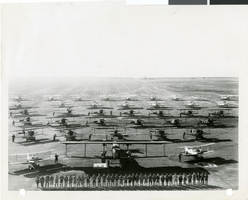
Photograph of pilots lined up in front of their biplanes at the Oakland Airport, California, March 15, 1929
Date
1929
Archival Collection
Description
Stunt pilots for the film Hell's Angels line up before the largest fleet of World War I planes ever assembled for the making of a motion picture. The event took place on the runway of the Oakland Airport, March 15, 1929.
Image
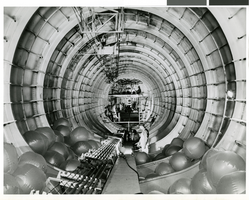
Photograph of men working on the interior of the Hughes HK-1 Flying Boat, Los Angeles Harbor, October 31, 1947
Date
1947-10-31
Archival Collection
Description
Men working inside the HK-1, Hughes Flying Boat, on Terminal Island in the Los Angeles Harbor.
Image
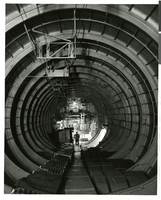
Photograph of the interior of the Hughes HK-1 Flying Boat, Los Angeles Harbor, October 31, 1947
Date
1947-10-31
Archival Collection
Description
Men working inside of the HK-1, Hughes Flying Boat on Terminal Island in the Los Angeles Harbor. Transcribed from note on back of photo: "Inside the Boat: Shown in a view looking toward the tail of the Hughes Flying Boat, the man is dwarfed by the giant interior of the airplane."
Image
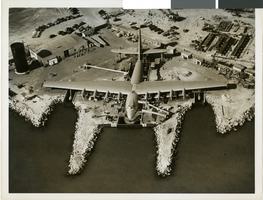
Aerial photograph of the Hughes HK-1 Flying Boat at Terminal Island in the Los Angeles Harbor, circa 1946
Date
1946
Archival Collection
Description
Aerial view of Hughes HK-1, Flying Boat. The plane was designed and built by Howard Hughes; it it shown near completion at its graving dock at Terminal Island in the Los Angeles Harbor. Transcribed from note on back of photo: "World's largest airplane--After Ground tests here the plane will undergo extensive water-taxi tests."
Image
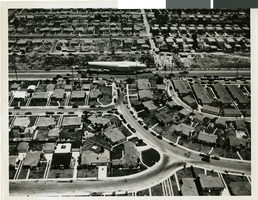
Photograph of the hull of the Hughes Flying Boat being transported from Culver City to Terminal Island, California, 1946
Date
1947
Archival Collection
Description
The hull of the $20,000,000 airplane, also known as the Flying Boat or Spruce Goose, being transferred from Culver City to Terminal Island in the Los Angeles Harbor. The Flying Boat was moved to Terminal Island's graving dock where construction was completed in June of 1947.
Image
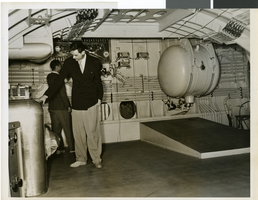
Photograph of Howard Hughes and crew member inside of the HK-1 Flying Boat, 1947
Date
1947
Archival Collection
Description
Howard Hughes inspecting the equipment on the flight deck inside of the HK-1, Hughes Flying Boat, which he designed and built. The man pictured behind Hughes is possibly Earl Martyn, Hughes' flight engineer. The Flying Boat was near completion and was located on Terminal Island in the Los Angeles Harbor.
Image

Photograph of Howard Hughes and Joe Petralli inspecting the HK-1, Hughes Flying Boat, as it nears completion, 1947
Date
1947
Archival Collection
Description
Howard Hughes (left, in dark coat) noted designer, builder, and industrialist entering the hull of the Hughes Flying Boat, the largest airplane in the world, as it was nearing completion on Terminal Island in the Los Angeles Harbor. With him is Joe Petralli, assistant director of service and flight.
Image
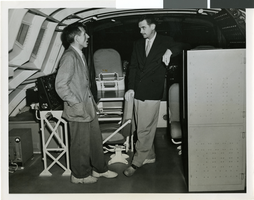
Photograph of Howard Hughes and Earl Martyn in the cockpit of the Hughes Flying Boat, Los Angeles Harbor, 1947
Date
1947
Archival Collection
Description
Howard Hughes (right) and Earl Martyn inside of the HK-1, Hughes Flying Boat, which was near completion on Terminal Island in the Los Angeles Harbor. The Hughes Flying Boat, also called the Spruce Goose, was the largest plane in the world.
Image
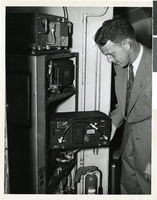
Photograph of crew member inside the HK-1, Hughes Flying Boat, as it nears completion, Los Angeles Harbor, 1947
Date
1947
Archival Collection
Description
Possibly Richard Stoddart or Earl Martyn inside of the Hughes Flying Boat, examining its equipment near as it was nearing completion.The Flying Boat was assembled on Terminal Island in the Los Angeles Harbor.
Image

Photographs for press release, Hughes demonstrates new radar warning, May 1, 1947
Date
1947-05-01
Archival Collection
Description
Photographs that accompany the attached press release: "HUGHES DEMONSTRATES NEW RADAR WARNING Howard Hughes, at the controls of the TWA Constellation, demonstrates the efficiency of his new radar safety device, which is being installed on all TWA planes and which will be available to all other airlines in the United States as soon as he can produce the equipment. The instrument warns the pilot by a brilliant red light and a warning horn the instant the plane comes too close to the ground, or any building, bridge, mountain, aircraft or other obstacle, regardless of darkness or weather conditions. The device weighs only 16 pounds and costs about $130. (Arrow points to warning lights on instrument panel). Center photo shows the Hughes-piloted Constellation approaching a mountain in Southern California's Santa Monica Range, an area usually voided by pilots because of its dangerous peaks. This particular plane's radar set was equipped with both 500-feet and 2,000-feet warning signals. The 500-feet warning range now being installed on TWA airliners was developed first because the greatest immediate need for it is during approaches and landings. The 2,000-feet warning is designed from enroute flying to guarantee clearance of mountains and other obstacles. Photo at right shows the Constellation veering to the left and climbing at a speed of 300 miles an hour after receiving radar warning of an obstacle in its flight path."
Image
Pagination
Refine my results
Content Type
Creator or Contributor
Subject
Archival Collection
Digital Project
Resource Type
Year
Material Type
Place
Language
Records Classification
